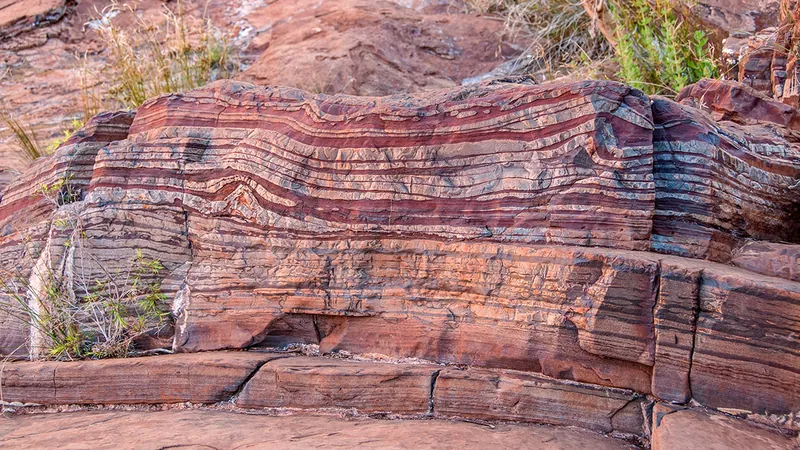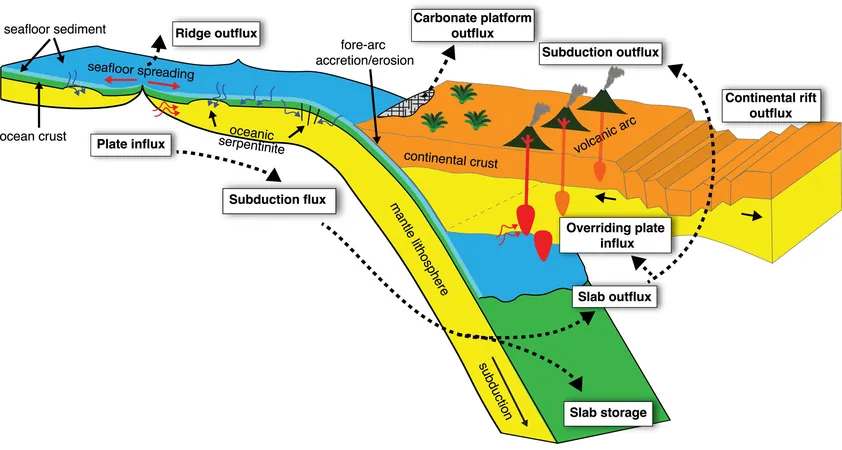
Unveiling the Ancient Battle: How Bacteria Fought for Iron in Earth’s Primitive Oceans
2024-11-15
Author: Yu
Introduction
In a groundbreaking discovery, researchers have shed light on the fierce competition among bacteria for iron in Earth's early oceans, a phenomenon that played a crucial role in shaping our planet's geological history. Banded iron formations (BIFs), characterized by their vivid red coloration and alternating layers of iron and chert, are invaluable records of this ancient battle. These remarkable sedimentary rocks are believed to have formed over 1.8 billion years ago during the Archean eon when microbial life thrived in conditions devoid of oxygen.
Research Findings
A recent study published in *Nature Geoscience* reveals that different strains of bacteria were not just coexisting but competing for iron, employing toxic strategies to outmaneuver each other. According to Casey Bryce, a geobiologist at the University of Bristol and coauthor of the study, "Our findings illustrate the dynamics of microbial communities that influenced BIF precipitation in previously unrecognized ways."
The Archean Environment
In the Archean era, the absence of oxygen in both the atmosphere and oceans created an environment very different from our present-day Earth. Iron oxidation, which typically leads to rusting in the presence of oxygen, posed a significant challenge for these early microbes. Dominating the microbial scene were photoferrotrophs—bacteria that oxidized iron using sunlight, allowing sediments rich in oxidized iron to accumulate over millennia to depths of up to 900 meters (3,000 feet).
Competition Among Bacteria
However, this new research indicates that photoferrotrophs weren’t the sole players in this iron feast. The study focused on the competition between photoferrotrophs and nitrate-reducing bacteria, microbes that could utilize nitrate to react with iron. The results were startling: when both types of bacteria were cultivated together, photoferrotrophs struggled, demonstrating slower growth rates and even rapid die-off—an alarming turn of events attributed to a chemical weapon produced by their competitors: nitric oxide.
Implications of the Findings
Bryce remarked, "We were surprised not only by the competition but also by the toxic dynamics at play. We always knew nitrate-reducing bacteria were formidable, but this aspect of their biology was unexpected." This revelation indicates that nitrate reducers played a significant role in shaping the microbial landscape, potentially enabling them to thrive as environmental conditions changed.
The Rise of Cyanobacteria
As photosynthetic cyanobacteria began to dominate coastal waters, producing oxygen in the process, the previously thriving photoferrotrophs found themselves pushed into less favorable environments with limited access to essential nutrients. The rise of cyanobacteria and changes in ocean chemistry may have severely restricted the photoferrotrophs, allowing nitrate-reducing bacteria to flourish and continue the cycle of BIF formation.
Future Research Directions
This research paves the way for further inquiries into the complexities of ancient microbial interactions and their influence on Earth’s geological history. Leslie Robbins, a geobiologist at the University of Regina, emphasizes the necessity of deepening our understanding of these dynamics: "We have an intricate puzzle to solve, and studies like this help us uncover the layers of microbial life that shaped our planet's early oceans."
Conclusion
As scientists continue to unravel these ancient biological interactions, we are left to wonder: what other hidden battles for survival unfolded in the depths of our planet's primordial seas? The story of bacteria battling for iron is just the tip of the iceberg in understanding Earth’s complex geological history. Stay tuned for more revelations from our planet’s mysterious past!


 Brasil (PT)
Brasil (PT)
 Canada (EN)
Canada (EN)
 Chile (ES)
Chile (ES)
 España (ES)
España (ES)
 France (FR)
France (FR)
 Hong Kong (EN)
Hong Kong (EN)
 Italia (IT)
Italia (IT)
 日本 (JA)
日本 (JA)
 Magyarország (HU)
Magyarország (HU)
 Norge (NO)
Norge (NO)
 Polska (PL)
Polska (PL)
 Schweiz (DE)
Schweiz (DE)
 Singapore (EN)
Singapore (EN)
 Sverige (SV)
Sverige (SV)
 Suomi (FI)
Suomi (FI)
 Türkiye (TR)
Türkiye (TR)